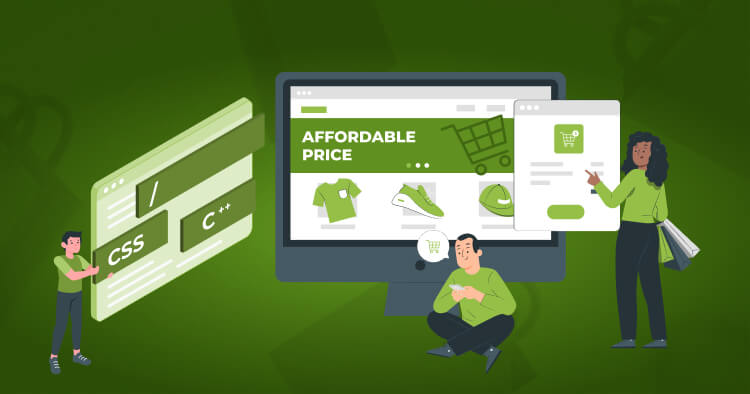Everything You Need to Know About Shopify Website Design Pricing in 2024
Last Updated | July 12, 2024
Table of Contents
As much as Shopify makes it easy to set up a professional-looking online store, many merchants still struggle with Shopify website design pricing and the cost of maintaining their store.
When it comes to creating a successful eCommerce website, budgeting for design and development is crucial. It helps you determine how much money you need to invest in your store up front. Also, it helps determine how much you can expect to pay for ongoing maintenance and updates.
This web design pricing guide on Shopify acts as your compass. It offers a breakdown of the costs you can expect to incur when creating your online store.
Does Shopify Design Your Website?
Shopify does not design websites for you. However, it offers merchants a range of customizable templates that are useful for designing your storefronts.
These themes are user-friendly and adaptable. The store owners can choose their layout, color scheme, and branding without specialized web design knowledge.
For those looking for a more bespoke design, Shopify has the solution, as it permits modifications through its coding language.
On the other hand, you can also hire a Shopify expert to craft a unique look. In this case, it all depends on the store owner or the hired professional to create and customize the design that reflects the brand identity.
Regardless of your approach, the aim is to prepare a website capable of fulfilling business needs without breaking the bank.
Shopify Website Design Pricing
The Shopify web designer’s cost range depends on the type of pricing model you choose. Primarily, there are three types of pricing models for Shopify website design–time-based, fixed, and value-based.
All of them have some positive and negative aspects. So, let’s explore them in detail now:
1. Time-Based Pricing Mode
Time-based pricing is about charging clients for hourly work done. So, for time-based projects, each hour counts until the design is finalized. This model best suits freelance developers and agencies that offer customized Shopify store creation services.
Here’s what you can expect with time-based pricing models:
- Track Time Efficiently: Utilize reliable time-tracking applications to ensure accurate records of work performed.
- Communication: Keep clients updated throughout the project to maintain transparency and confidence.
- Experience: New freelancers or agencies may benefit from adopting time-based pricing initially, as it demonstrates expertise and builds credibility.
While time-based pricing remains popular within the creative industries, alternative approaches—such as fixed or value-based pricing—may offer greater stability and predictability for both parties.
Pros of Time-Based Pricing
- Transparency and flexibility are key advantages of time-based models.
- Clients are informed about the costs associated with each development stage.
- This model easily adapts to project changes or additions.
- Particularly beneficial for projects evolving iteratively or needing frequent client input.
Cons of Time-Based Pricing
- Cost variability is a primary issue.
- Improper initial time estimations lead to budget overruns.
- Budget overruns may exceed client expectations.
- Uncertainty can lead to design revisions.
- Projects with frequent change requests introduce ambiguity.
When Does Time-Based Pricing Make Sense?
This model excels in scenarios where
- The project scope is fluid or subject to ongoing changes.
- Close collaboration and client feedback are crucial.
- The project involves specialized skills or unique requirements.
2. Fixed Pricing Model
Fixed pricing is a clear approach where the cost remains steady regardless of market fluctuations. It’s a preferred model with stable demand and known production costs. Essentially, it gives customers stability in their purchases.
Some good examples of fixed pricing are:
- Retail items: Products such as groceries or clothing are sold at a fixed price in brick-and-mortar stores.
- Subscription services: Monthly fees for access to content or software remain constant.
- Training programs: Organizations pay a flat fee for a training package, covering all activities included in the program.
- Software licenses: Companies purchase a license to use software for a fixed duration or number of users.
Pros of Fixed Pricing
- Cost certainty attracts customers by providing clarity on financial commitment.
- Clients benefit from knowing their exact costs upfront.
- Informed budgeting and simplified financial planning are facilitated.
- Motivates designers to meet deadlines while maintaining quality standards.
Cons of Fixed Pricing
- Inability to accommodate project changes.
- Concern for clients seeking flexibility or requiring unforeseen modifications.
- Fixed pricing is disadvantageous for projects with highly specific requirements.
- Accurately estimating effort can be challenging.
When Does Fixed Pricing Make Sense?
This model excels in scenarios in which
- The project scope is well-defined and unlikely to change significantly.
- Budget predictability is paramount.
- The project involves straightforward features and functionalities.
3. Value-Based Pricing Model
Value-based pricing is a strategy where the price of a product or service is determined by its perceived value to customers rather than production costs. This approach focuses on understanding customers’ willingness to pay and aligning prices with the value they receive.
How Value-Based Pricing Works
- Customer Perception: The price is set based on how much customers value the product or service.
- Differentiation: Businesses must offer unique value propositions to justify higher prices.
- Market Research: Surveys and customer feedback help determine customers’ perceived value.
- Optimal Pricing: Finding the balance between maximizing profits and customer satisfaction.
Pros of Value-Based Pricing
- Fosters a collaborative environment based on the client’s goals.
- Both parties share an interest in the website’s success.
- Designers develop a highly effective and strategic website aligned with the client’s desired outcomes.
- Offers transparent results, enhancing trust between clients and designers.
Cons of Value-Based Pricing
- Quantifying the website’s impact on business metrics can lead to disputes.
- Trust and clear communication between the client and designer are essential.
- Success depends on an accurate understanding of shared goals.
When Does Value-Based Pricing Make Sense?
Value-based pricing web design model helps in situations where
- The client has quantifiable business goals for their website.
- Trust and open communication are crucial.
- The focus is on long-term business impact.
Choose a Price Based on What Feels Right
You have equipped yourself with the knowledge to make the best choice on the Shopify website design pricing venture. So be confident and begin the journey to your result-oriented Shopify store.
These Shopify web design pricing guidelines are the key to finding the right pricing model for your business needs. Remember, the affordably yet perfect Shopify website is just a well-informed decision away.
FAQs
How much does it cost to design a website on Shopify?
Designing a website on Shopify costs vary widely based on complexity and features. Expect to budget anywhere from a few hundred to several thousand dollars.
How much do Shopify designers charge?
Shopify designers typically charge based on project scope and expertise. Rates can range from $50 to $150 per hour or more, depending on the designer’s experience and location.
How much should I pay someone to build a Shopify website?
The cost to build a Shopify website depends on customization needs. Basic setups can start around $500-$1,000, while complex designs with custom features may range from $2,000 to $10,000 or more.
Is it free to build a website on Shopify?
Shopify offers a 14-day free trial, but beyond that, you’ll need to choose a paid plan starting at $29 per month. Additional costs may include themes, apps, and development fees.
How much can I charge for website design?
Website design pricing varies based on factors like complexity, client needs, and your expertise. Rates typically range from $500 to $5,000 or more per project.
Can I pay Shopify to build my website?
Shopify itself does not offer direct website building services, but you can hire Shopify Experts or agencies who specialize in Shopify development to build your website for a fee.








